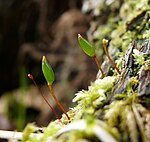Portal:Plants/Selected article/23
Buxbaumia (bug moss, bug-on-a-stick, humpbacked elves, or elf-cap moss) is the botanical name for a genus of twelve species of moss (Bryophyta). It was named in 1801 by Johann Hedwig to commemorate Johann Christian Buxbaum, a German physician and botanist who discovered the moss in 1712 at the mouth of the Volga River.
Plants of Buxbaumia have a much reduced gametophyte, bearing a sporophyte that is enormous by comparison. In most mosses, the gametophyte stage of the life cycle is both green and leafy, and is substantially larger than the spore-producing stage. Unlike these other mosses, the gametophyte of Buxbaumia is microscopic, colorless, stemless, and nearly leafless. It consists exclusively of thread-like protonemata for most of its existence, resembling a thin green-black felt on the surface where it grows. The plants are dioicous, with separate plants producing the male and female organs. Male plants develop only one microscopic leaf around each antheridium, and female plants produce just three or four tiny colorless leaves around each archegonium. Because of its small size, the gametophyte stage is not generally noticed until the stalked sporangium develops, and is locatable principally because the sporangium grows upon and above the tiny gametophyte. The extremely reduced state of Buxbaumia plants raises the question of how it makes or obtains sufficient nutrition for survival. In contrast to most mosses, Buxbaumia does not produce abundant chlorophyll and is saprophytic.

